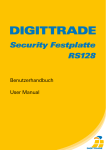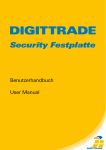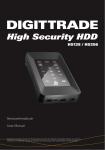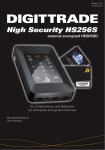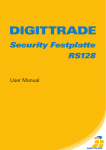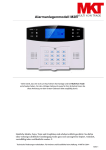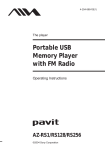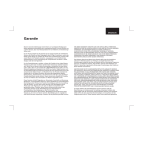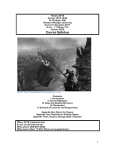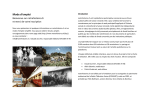Download Digittrade RS256 120GB SSD
Transcript
Security Festplatte RS256 Benutzerhandbuch User Manual Das Gerät Anschluss an USB 3.0 / 2.0 Steckplatz Inbetriebnahme der Festplatte Sperren und Entsperren der Festplatte Partitionierung / Formatierung unter Windows Partitionierung / Formatierung unter MAC OS X Partitionierung / Formatierung unter Linux Das richtige Dateisystem Technische Spezifikationen RFID Transponder Schutzsysteme Datensicherheit und Haftungsausschluss FAQ - häufig gestellte Fragen Hinweis zum Schutz und Erhalt der Umwelt 4 5 6 6 7 13 16 21 23 24 25 26 27 29 3 Deutsch Inhaltsverzeichnis Anschluss an USB 3.0 / 2.0 Steckplatz Verbinden Sie die Festplatte mit Ihrem PC durch das im Lieferumfang enthaltene USB-Kabel. An-/Ausschalter Status-LED Signalempfänger (RFID) Mini-USB Anschluss Stromanschluss 4 5 Deutsch Deutsch Das Gerät Schieben Sie den Schalthebel in Richtung „AN“. Zur Bestätigung leuchtet die Status-LED grün. Die Festplatte ist bei Auslieferung bereits im NTFSDateisystem vorformatiert. Sperren und Entsperren der Festplatte Um unbefugten Zugriff auf Ihre sensiblen Dateien zu verhindern, ist die Festplatte immer im gesperrten Zustand und muss für die Nutzung entsperrt werden. Dazu führen Sie einen der beiden beigelegten RFID-Schlüssel über das Empfangssymbol der Festplatte. Die Festplatte ist entsperrt, wenn ein kurzes Tonsignal ertönt und die LED aufleuchtet. Anschließend wird die Festplatte automatisch vom System erkannt. Hinweis: Die Festplatte kann ebenfalls durch das erneute Auflegen des Schlüssels oder durch das Ausschalten der Festplatte gesperrt werden. Partitionierung / Formatierung der Festplatte unter Windows Es besteht die Möglichkeit, die Festplatte in eine oder mehrere Partitionen einzuteilen. - Gehen Sie in die Systemsteuerung und klicken Sie „Verwaltung“ doppelt an. - Öffnen Sie die „Computerverwaltung“ wählen Sie „Datenträgerverwaltung“. und Sobald Sie die Stromzufuhr zur Festplatte unterbrechen, ist diese sofort wieder gesperrt. Somit sind Ihre Dateien sofort wieder vor unbefugtem Zugriff geschützt. 6 7 Deutsch Deutsch Inbetriebnahme der Festplatte Deutsch Deutsch - Wählen Sie mit der Maus die externe Fest platte aus und öffnen Sie mit der rechten Maustaste das Kontextmenü. - Um die Festplatte zu formatieren, wählen Sie den Menüpunkt „Formatieren“. Hinweis: Alle Daten werden unwiderruflich gelöscht und können nach der Formatierung nicht wiederhergestellt werden. Es öffnet sich jetzt der Partitionierungsassistent. Um die Festplatte zu partitionieren, wählen Sie den Punkt „Volumen verkleinern“ aus. - Tragen Sie den gewünschten Speicherplatz (in MB) ein, auf den die Partition verkleinert werden soll. - Es wird jetzt ein nicht zugeordneter Bereich im Verwaltungsbildschirm angezeigt. - Markieren Sie den nicht zugeordneten Bereich mit der Maus und öffnen Sie das Kontextmenü mit der rechten Maustaste und wählen Sie den Punkt „neues einfaches Volumen”. 8 - Klicken Sie auf „Weiter”. 9 Deutsch Deutsch - Sie können der Partition einen Laufwerksbuch staben zuweisen. - Klicken Sie anschließend auf „Weiter“. - Tragen Sie die gewünschte Größe der Partition in MB ein und klicken Sie dann auf „Weiter“. 10 11 Partitionierung / Formatierung unter MAC OS X Nachfolgend wird beschrieben, wie Sie das Dateisystem und die Partitionsgröße ändern können. - Öffnen Sie unter „Programme“ „Dienstprogramme“ den Punkt - Die Partitionierung wird abgeschlossen, bestätigen Sie diesen Vorgang indem Sie auf „Fertig stellen“ klicken. Hinweis: Der neu partitionierte Bereich wird nun formatiert. Nach Abschluss der Formatierung wird die neue Partition automatisch vom System erkannt. 12 13 Deutsch Deutsch - Wählen Sie das gewünschte Dateisystem, die Art der Formatierung und klicken Sie auf „Weiter“. Deutsch Deutsch - Wählen Sie „Festplatten-Dienstprogramm“ aus. - Wählen Sie anschließend aus der linken Laufwerks übersicht die externe Festplatte aus. - In diesem Menü können Sie die Partitions größen ändern, ganze Partitionen löschen oder neue Partitionen erstellen. - Wählen Sie im Hauptregister „Partitionieren“ aus. 14 die Option 15 Es besteht die Möglichkeit, die Festplatte in mehrere Partitionen zu teilen. Die dazu nötige Vorgehensweise wird Ihnen hier auf der Basis von YaST von Suse Linux beschrieben. Dieser Vorgang ist unter anderen Linux Distributionen ähnlich. - Aus Sicherheitsgründen öffnet sich ein Fenster und Sie werden gefragt, ob Sie mit der Partitionierung bereits vertraut sind. Bestätigen Sie diese Meldung mit „JA”. - Darauf folgend öffnet sich die Datenträger tabelle Ihres Systems. - Öffnen Sie zuerst YaST. Sie werden ggf. dazu aufgefordert sich zu authentifizieren. - Hier können Sie den gewünschten Datenträger auswählen, partitionieren oder bereits vorhandene Partionen bearbeiten bzw. löschen. - Wählen Sie auf der linken Seite “System” und im rechten Feld „Partitionieren” aus. 16 - Zum Löschen der vorhandenen NTFS Partition wählen Sie diese mit dem Cursor aus und klicken anschließend auf „Löschen”. 17 Deutsch Deutsch Partitionierung / Formatierung unter Linux - Sie werden vom System gefragt, ob Sie die Partition wirklich löschen wollen. Vergewissern Sie sich an diesem Punkt, dass Sie die richtige Partition ausgewählt haben und bestätigen Sie mit dem Klick auf „Ja”. Hinweis: Beim Löschen der Partition werden auch alle auf der Partition befindlichen Dateien unwiderruflich gelöscht. - Zum Erstellen einer neuen Partition auf dem freien Speicher des Datenträgers klicken Sie auf „Erstellen”. - Entscheiden Sie sich, auf welchem Datenträger Sie eine neue Partition erstellen möchten. 18 - In diesem Fenster legen Sie alle Merkmale für die Partition fest. So können Sie zwischen verschiedenen Dateisystemen wählen, die Größe bestimmen und bei Bedarf sogar den Einhänge punkt in Ihr Linux-System festlegen. - Bestätigen Sie abschließend alle Ihre Angaben mit „OK”. Hinweis: Linux bietet zusätzlich die Möglichkeit, die Festplatte zu verschlüsseln. Jedoch müssen Sie hierbei mit eventuellen PerformanceEinschränkungen rechnen. 19 Deutsch Deutsch - Im nächsten Schritt werden Sie nach der Art der Partition gefragt. Hierbei empfiehlt es sich in den meisten Fällen die „Primäre Partition” auszuwählen. - Setzen Sie anschließend den Haken bei „Formatieren” und wählen Sie ein passendes Dateisystem aus. Bestätigen Sie alle Angaben mit „OK”. Deutsch Deutsch - Die Formatierung erfolgt ähnlich. Wählen Sie hierzu die gewünschte Partition aus und klicken Sie auf „Bearbeiten” - In einem neuen Fenster werden alle Ihre Änderungen aufgelistet. Vergewissern Sie sich erneut, dass alle Änderungen genau Ihrem Wunsch entsprechen und bestätigen Sie Ihre Einstellungen indem Sie auf „Anwenden” klicken. Hinweis: Sollten Sie sich bei der Wahl des richtigen Dateisystems und der jeweiligen Partitionsgröße unsicher sein, empfiehlt es sich, die automatisch eingetragenen Werte zu übernehmen. Das richtige Dateisystem - Damit Ihre Änderungen wirksam werden, klicken Sie auf „Anwenden”. 20 In der nachstehenden Tabelle sehen Sie die Kompatibilität zwischen den Betriebs- und Dateisystemen. 21 FAT32 HFS+ EXT4 Win 98 X L, S X X Win NT, 2000, ME, XP, Vista L, S L, S X X Mac OS X L L, S L, S X Linux L L, S X L, S L - Lesen S - Schreiben X - Keine Kompatibilität Die DIGITTRADE Security Festplatte RS256 ist zum Zeitpunkt der Auslieferung bereits im NTFSDateisystem vorformatiert. In obiger Tabelle sehen Sie die Kompatibilität von NTFS zu Ihrem Betriebssystem. Sollte NTFS nicht zu Ihrem Betriebssystem passen, so können Sie die Festplatte in einem passenden Dateisystem formatieren. (Siehe Kapitel: „Partitionieren / Formatieren” - S. 10) Für Nutzer von Windowssystemen empfehlen wir NTFS zu verwenden. Für Mac OS X ist HFS+ das leistungsstärkste Dateisystem und bei Linux sollten Sie EXT4 verwenden. Selbstverständlich ist es 22 auch möglich, die DIGITTRADE Security Festplatte RS256 mit jedem anderen Dateisystem zu formatieren. Dies beeinflusst die Verschlüsselung der Daten nicht. Wenn Sie die Festplatte unter verschiedenen Betriebssystemen verwenden möchten, können Sie die Festplatte auch partitionieren und den einzelnen Partitionen verschiedene Dateisysteme zuweisen. Beachten Sie hierbei auch die für das Dateisystem spezifischen Einschränkungen bzw. Unterschiede. Technische Spezifikationen Bus-Typ: unterstützte Kapazität: Umdrehungen: Transferrate: SATA 3Gb/s 160 GB - 1 TB 5400 - 7200 UPM USB 3.0 max 5 Gbit/s USB 2.0 max 480 MBits/s Zugriffszeit: anhängig vom Speichermedium Puffer: 8192 - 16384 KB Akustische Geräuschentwicklung: <24 dBA Die Umrechnung von Byte zu KByte, MByte, GByte und TByte erfolgt von Festplattenherstellern und Computern unterschiedlich. Festplattenhersteller rechnen im metrischen Zahlensystem 23 Deutsch Deutsch NTFS Kapazität lt. Hersteller 160 GB 250 GB 320 GB 500 GB 640 GB 750 GB 1000 GB verfügbare Kapazität 149,01 GB 232,83 GB 298,02 GB 465,66 GB 596,03 GB 698,49 GB 931,32 GB Es werden ausschließlich Qualitätsfestplatten der Marke Samsung eingebaut. RFID-Transponder RFID (Radio Frequency Indentification) ist die Identifizierung mit Hilfe von elektromagnetischen Wellen. Ein RFID-System besteht aus einem Transponder, der sich an einem Gegenstand befindet und einem Lesegerät zum Auslesen der Transponderkennung. 24 Schutzsysteme RFID-Zugriffskontrolle Der für den Zugriff auf die Festplatte notwendige 128-Bit-Schlüssel ist nach Advanced Encryption Standard (AES) verschlüsselt gespeichert. Datenverschlüsselung Die Daten auf der DIGITTRADE Security Festplatte RS256 werden durch ein integriertes Verschlüsselungsmodul mit 256-Bit nach AES verschlüsselt. Der AES-Verschlüsselungsalgorithmus bietet ein sehr hohes Maß an Sicherheit. Das Verfahren wurde eingehend kryptoanalytischen Prüfungen unterzogen und ist in den USA für staatliche Dokumente mit höchster Geheimhaltungsstufe zugelassen. Das vom Verschlüsselungsmodul angewandte Verfahren entspricht den FIPS 197 Richtlinien. Die DIGITTRADE Security Festplatte RS256 bietet somit optimalen Schutz für Ihre Daten auch bei Verlust oder Diebstahl des Datenträgers. 25 Deutsch Deutsch (1 kByte = 103 Byte = 1000 Byte). Computer verwenden auf Grund ihrer Bauweise das Binärsystem (1 kByte = 210 Byte = 1024 Byte). Daraus ergeben sich folgende Unterschiede bei der Darstellung der Speicherkapazität: Wir empfehlen Ihnen, die sich auf der DIGITTRADE Security Festplatte RS256 befindenden Daten regelmäßig auf anderen Speichermedien zusätzlich zu sichern. Dies schützt Sie vor einem vollständigen Datenverlust. Die DIGITTRADE GmbH haftet nicht für den Verlust von Daten, sowie für die dadurch entstehenden Kosten und Schäden. Des Weiteren ist es notwendig, dass Sie uns Ihr vollständig ausgefülltes Besitzer-Zertifikat zukommen lassen. Nur mit diesem kann ein Missbrauch des Schlüsselnachbaus ausgeschlossen werden. Bitte teilen Sie uns den Verlust bzw. Diebstahl Ihrer Festplatte unverzüglich mit. Dadurch kann der Nachbau der Schlüssel verhindert werden. FAQ - häufig gestellte Fragen Aufbewahrung der Schlüssel Die Festplatte wird nicht vom System erkannt. Zum Lieferumfang der DIGITTRADE Security Festplatte RS256 gehören jeweils zwei RFID-Schlüssel. Der Zugriff auf die Festplatte ist nur mit diesen Schlüsseln möglich. Bei Defekt oder Verlust eines Schlüssels setzen Sie sich bitte umgehend mit uns in Verbindung. Bitte bewahren Sie immer einen der beiden Schlüssel an einem sicheren Ort auf. Prüfen Sie, ob das USB-Kabel richtig angeschlossen ist. Anschließend überprüfen Sie bitte, dass der Anund Ausschalter an der Oberseite auf der Einstellung „An“ steht. Danach prüfen Sie bitte, ob die Festplatte mit dem beigelegten Schlüssel korrekt entsperrt wurde. (Siehe auch ab Kapitel: „Anschluss an USB 3.0 / 2.0 Steckplatz” - S. 5 f) Sollten beide Schlüssel verloren gegangen oder defekt sein, ist kein Zugriff auf den Datenträger mehr möglich. 26 27 Deutsch Deutsch Datensicherheit und Haftungsausschluss Hinweis zum Schutz und Erhalt der Umwelt Überprüfen Sie, ob die Festplatte mit dem richtigen Dateisystem für Ihr Betriebssystem formatiert ist. Gemäß der EG-Richtlinie dürfen Elektro- und Elektronik-Altgeräte nicht mehr als kommunale Abfälle entsorgt werden. Zur Vermeidung der Verbreitung der enthaltenen Bausubstanzen in Ihrer Umgebung und zur Einsparung natürlicher Ressourcen bitten wir Sie, dieses Produkt nach Ablauf seiner Lebensdauer ausschließlich an einer lokalen Altgerätesammelstelle in Ihrer Nähe abzugeben. Dank dieser Maßnahmen können die Materialien Ihres Produktes umweltfreundlich wiederverwendet werden. Das NFTS-Dateisystem kann nur von WindowsNutzern verwendet werden. (Siehe Kapitel: „Das richtige Dateisystem” - S. 29) Ich habe einen oder beide Schlüssel verloren. Setzen Sie sich bitte umgehend mit unserem Support in Verbindung: Tel.: 0345 / 2317353 E-Mail: [email protected] Ausführliche Informationen finden Sie auch in unserem Online-Shop auf www.digittrade.de. Ihre Fragen beantworten wir gerne telefonisch unter 0345/2317353 oder per E-Mail [email protected] 28 29 Deutsch Deutsch Ich kann keine Dateien auf die Festplatte schreiben. The Device Connection to USB 3.0 / 2.0 Port Switching-On Locking and Unlocking the Hard Drive Partitioning / Formatting using Windows Partitioning / Formatting using MAC OS X Partitioning / Formatting using Linux The Correct File System Technical Specifications RFID Transponder Protection System Data Security and Disclaimer FAQ - Frequently Asked Questions WEEE Statement 32 33 34 34 35 40 43 47 49 50 51 52 53 55 31 English Contents Connection to USB 3.0 / 2.0 Port Connect the DIGITTRADE Security Hard Drive RS256 to your PC using the USB cable included in delivery. On/Off Switch Status LED Signal Receiver USB Port AC Port 32 33 English English The Device Move the control lever to “An” (On). The LED status will turn on green light. The DIGITTRADE RS256 HDD is already preformatted in the NTFS file system. Locking and Unlocking the Hard Drive Partitioning / Formatting using Windows Please follow the instructions to customise the file system, partition size and number of partitions. - Go to “control panel” and double click on “Administrative Tools”. - Open the “Computer Management” and choose “Disk Management”. To avoid unauthorized access to your sensitive data the DIGITTRADE Security Hard Drive RS256 is always locked and needs to be unlocked for use. Hold one of the two enclosed RFID keys above the reception symbol of the hard drive. The hard drive will be unlocked, if you hear a short acoustic signal and the green LED flashs. The hard drive will be identified by the system. If you unplug the hard drive from the system it will be unlocked again. Your data will immediately be protected against unauthorized access. Note: The hard drive also can be locked by holding the key again over the reception symbol or by turning it off. 34 - Choose with your mouse the external hard drive and open the context menu using the right mouse button. 35 English English Switching-On English English - choose the menu item “Formatting” to format the hard drive Note: All data will be deleted irrevocably and cannot be restored after formatting. To partition the hard drive choose the item “Shrink Volume”. - Type in the desired memory capacity (in MB). - An unassigned field will be shown in the adminis tration display. - Click on “Next”. - Mark this unassigned field with the mouse and open the context menu with the right mouse button and choose the item “New Simple Volume”. The partitioning assist will appear. 36 - Type in the desired size of the partition in MB and click on “Next”. 37 - Choose a drive letter for the partition. - Click on “Next”. - The partitioning will be finished now, confirm this action by clicking on “Finish”. Note: The newly partitioned field will be formatted now. After the formatting is completed the new partition will be automatically identified by the system. 38 39 English English - Choose the desired file system, the type of formatting and click on “Next”. - Choose from the left drive overview the external hard drive. Please follow the instructions to customise the file system, partition size and number of partitions. - Select “Utilities” from “Applications”. - Choose from “Partition”. the main index the option - Choose “Disk Utility”. 40 41 English English Partitioning / Formatting using MAC OS X It is possible to divide the hard drive in several partitions. The instruction below is described on the base of YaST and Suse Linux. This procedure is similar under other Linux distributions. - First open YaST. If necessary, you will need to authenticate yourself. - In this menu you can change partition sizes, delete partitions or create new partitions. - Choose from the left side “System” and from the right field “Partitioner”. - For security reasons a window will open and you will be asked whether you are familiar with the partitioning. Confirm this with “Yes”. 42 43 English English Partitioning / Formatting using Linux Note: If you delete the partition, you will delete irrevocably all files stored on it. - To create a new partition in the free space of your volume click on “Create”. - Choose a volume to create the new partition. - Now you can choose the desired volume, partition it or edit or delete already existing partitions. - You will be asked which type of partition you want to create. It is recommended to use “Primary Par- tition”. - To delete the standard NTFS partition please click on it and afterwards on “Delete”. - You will be asked whether you really want to delete the partition. Make sure you have chosen the correct partition and confirm with a click on “Yes”. 44 45 English English - The volume table of your system will appear. - Click on “Apply” that your modifications operate. English English - In this window you decide features of the partition. You can choose between different file systems and sizes and if necessary you can configure a mountingpoint for Linux. Confirm your configuration with “OK”. Note: It is possible to encrypt your hard disk here additionally, but this may reduce the performance. - Formatting works similarly. Choose the desired partition and click on “Edit”. - Click on “Formatting” and choose the adequate file system. Confirm your configurations with “OK”. - All modifications will be shown in a new window. Make sure all the modifications are correct and confirm the configurations by clicking on “Apply”. Note: If you are not sure which file system or partition size to choose, we recommend taking the automatically entered values. The Correct File System - In the table below you can see the compatibility between operating systems and file systems. 46 47 FAT32 HFS+ EXT4 Win 98 X R, W X X Win NT, 2000, ME, XP, Vista, 7 R, W R, W X X Mac OS X R R, W R, W X Linux R R, W X R, W R - reading W - writing X - no compatibility With additional programs it could be possible to read or write on file systems, on which it usually is not possible. The DIGITTRADE Security Hard Drive RS256 is at the time of delivery already preformatted in the NTFS file system. In the table above you can see the compatibility of NTFS to your operating system. Should NTFS not be suitable to your operating system, you will have to format the hard drive again (see chapter: “Partitioning / Formatting”, p.42). For windows users we recommend using NTFS. For Mac OS X is HFS+ the most powerful file system and for Linux you should use EXT4. Naturally, it is also possible to format the 48 DIGITTRADE Security Hard Drive RS256 with every other file system. This does not affect the security features. If you want to use the hard drive using different operating systems, we recommend to use the FAT32 file system, since it can be read and written by almost every operating system. However, it will cause reductions in the maximum file size and partition size. Furthermore there will be performance differences. Technical Specifications Interface: Capacity: Spindle Speed: Data Transfer Rate: Access Time: Buffer Memory: Acoustic Idle: SATA 3Gb/s 160 GB - 1TB 5400 - 7200 RPM USB 3.0 max 5 GBits/s USB 2.0 max 480 MBits/s 12 ms 8192 - 16384 KB <24 dBA Computers and hard drive manufacturers convert differently from Byte to KByte, MByte and GByte. Hard drive manufacturers calculate in the metric 49 English English NTFS HDD Manufacturer True Capacity 160 GB 149,01 GB 250 GB 232,83 GB 320 GB 298,02 GB 500 GB 465,66 GB 640 GB 596,03 GB 750 GB 698,49 GB 1000 GB 931,32 GB Only hard drives of the manufacturer Samsung are assembled. RFID Transponder Protection system RFID Access Control The Access to the DIGITTRADE Security Hard Drive RS256 is protected using a 128 bit encryption according to AES by RFID. Data Encryption Data stored on the DIGITTRADE Security Hard Drive RS256 will be encrypted or decrypted automatically by an integrated hardware encryption module. This module is using 256 bit AES algorithm to encrypt or decrypt the data. This encryption technology offers the highest standard for mobile data security and is certified by the National Institute of Standards and Technology of the United States of America (NIST). The Advanced Encryption Standard (AES) specifies a FIPS-approved cryptographic algorithm (FIPS 197) that can be used to protect electronic data. RFID (Radio Frequency Identification) is the identification via electromagnetically waves. The RFID system contains of a transponder, which is included in an object and a reader for the readout of the transponder identification. 50 51 English English system (1 kByte = 103 Byte = 1000 Byte) and computers use due to their construction the dual system (1 kByte = 210 Byte = 1024 Byte). The outcomes of this are the following differences in the representation of the memory capacity. We recommend storing continuously the data saved on the DIGITTRADE Security Hard Drive RS256 on other storage media. This will protect you against a total data loss. The DIGITTRADE GmbH is not liable for data loss and thereby emerging costs and damages. Storage of the Keys There are two RFID keys included in delivery of the DIGITTRADE Security Hard Drive RS256. The unlocking of the hard drive is only possible with one of these two keys. If a defect or a loss occurs, please contact us immediately. A replacement key will be provided for you with costs. Please keep one of the keys in a safe spot, since it will be needed for the production of the replacement key. If you lose both of the keys or they are defective, a reproduction of the key will be associated with an explicit higher complexity. Please advise us immediately if a loss or theft of your hard drive occurs. Thereby a reproduction of the key can be avoided. FAQ - Frequently Asked Questions The system does not identify the hard drive. Please check whether the hard drive was unlocked by the key enclosed and whether the power switch is in the correct state. Please check also whether the USB cable is connected correctly (see chapter: “Connection to USB 3.0/2.0 port”, p.34). I cannot write any files on the hard drive. Please check whether the hard drive was formatted with the correct file system for your operating system. The NTFS file system can only be used by Windows users (see chapter: “The Correct File System”, p.49). I lost one or both keys. Furthermore it is necessary to send us your fully completed Owner’s Certificate. Only with this an abuse of the key reproduction can be excluded. 52 Please contact immediately our support: Telephone: +49/ 345/ 2317353 E-mail: [email protected] 53 English English Data Security and Disclaimer We will gladly answer your questions on the telephone: (0049) 345/ 2317353 or by e-mail: [email protected]. 54 WEEE Statement According to the EC directive, waste electrical and electronic equipment (WEEE) must not be disposed as municipal wastes. To avoid the spread of the contained fabric components in your environment and to save natural resources we would like to ask you to hand this product after its economic life time only to a collecting point for WEEE in your area. Thanks to these measures, materials of your product can be reused environmentally friendly. 55 English English For detailed information visit our support center on www.digittrade.de. English © 2011 DIGITTRADE GmbH Deutsch Dieses Handbuch ist urheberrechtlich geschützt und darf nicht (auch nicht teilweise) ohne schriftliche Zustimmung der DIGITTRADE GmbH kopiert werden. English This user manual is protected by copyright. No part of this material may be reproduced, transcribed, used or disclosed to any third party in any form or by any means, without the written permission of DIGITTRADE GmbH. 56 DIGITTRADE GmbH Ernst-Thälmann-Str. 39 06179 Teutschenthal Germany Fon Fax E-Mail Web +49 / 345 / 2317353 +49 / 345 / 6138697 beratung@ digittrade.de www.digittrade.de
This document in other languages
- Deutsch: Digittrade RS256 120GB SSD






























